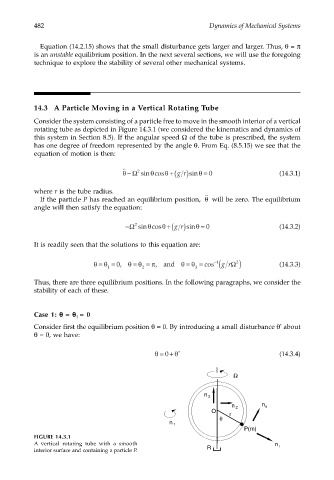Page 501 - Dynamics of Mechanical Systems
P. 501
0593_C14_fm Page 482 Tuesday, May 7, 2002 6:56 AM
482 Dynamics of Mechanical Systems
Equation (14.2.15) shows that the small disturbance gets larger and larger. Thus, θ = π
is an unstable equilibrium position. In the next several sections, we will use the foregoing
technique to explore the stability of several other mechanical systems.
14.3 A Particle Moving in a Vertical Rotating Tube
Consider the system consisting of a particle free to move in the smooth interior of a vertical
rotating tube as depicted in Figure 14.3.1 (we considered the kinematics and dynamics of
this system in Section 8.5). If the angular speed Ω of the tube is prescribed, the system
has one degree of freedom represented by the angle θ. From Eq. (8.5.15) we see that the
equation of motion is then:
˙˙ θ − Ω 2 sin cosθ +(gr ) sinθ = 0 (14.3.1)
θ
where r is the tube radius.
˙˙
If the particle P has reached an equilibrium position, θ will be zero. The equilibrium
angle will then satisfy the equation:
θ
−Ω sin cosθ +(gr )sinθ = 0 (14.3.2)
2
It is readily seen that the solutions to this equation are:
=
=
=
θθ = 0, θθ = π, and θ θ = cos −1 (grΩ 2 ) (14.3.3)
1 2 3
Thus, there are three equilibrium positions. In the following paragraphs, we consider the
stability of each of these.
Case 1: θθ θθ = θθ θθ = 0
1
Consider first the equilibrium position θ = 0. By introducing a small disturbance θ about
*
θ = 0, we have:
θ =+ θ * (14.3.4)
0
Ω
n 3
n n
n 2 θ
O
r
θ
n 1
P(m)
FIGURE 14.3.1
A vertical rotating tube with a smooth n r
interior surface and containing a particle P. R

